Early Office Museum
Stapler Gallery
~ Single Shot Staple Machines ~
The machines in the gallery below were loaded with one staple at a time. After that staple was used, the user reloaded the stapler with another staple. Single shot stapling machines for use in fastening loose papers were sold in the US and Europe until 1913, decades after stapling machines that could insert and clinch many staples without reloading had arrived on the market.
Three sets of inventors were responsible for most of the patents for single shot staplers:
1. Henry R. Heyl, whose 1877 patent (US Patent No. 195,603) was reissued (in modified form) in 1881. This patent was initially assigned to George W. Heyl (1862-1920) and then in 1881 was assigned to Isaac W. Heysinger, who was associated with the manufacturer Philadelphia Novelty Mfg. Co. This patent was listed on the Philadelphia Novelty Mfg. Co.'s Novelty, Keystone, and Original Paper Fasteners, which were introduced in 1880, 1883, and 1884, respectively. Two patents awarded to Heysinger in 1880 and 1883 were also listed on the Novelty and Keystone paper fasteners.
Isaac Winter Heysinger (1842-1917) lived a remarkable life. He fought in the Civil War, including the Battle of Antietam, and published a book on Antietam and campaigns of 1862. He was a phyician and published books on medicine and science. He was an inventor and obtained 36 patents for a wide variety of items during 1876-1906. He was also a collector of paintings whose holdings included works by Rembrandt and Titian.
2. George W. McGill, who was awarded patents in 1879 (US Patent No. 212,316) and 1882 (US Patent No. 252,841), and who was associated with the manufacturing firm Holmes, Booth & Haydens. McGill was awarded a very large number of patents for paper fasteners, paper fastening presses, staple presses, and paper clips.
3. William J. Brown, Jr., whose 1879 patent (US Patent No. 218,227) was used by Brown himself and whose 1882 patent (US Patent No. 260,365) was used by James P. Crawford. Crawford, who based the Victor Paper Fastener on Brown's patents, was associated with the manufacturer A. A. Weeks. A. A. Weeks was owned by Albertus A. Weeks.
There was a considerable amount of patent litigation among these three parties, specifically Heysinger, McGill, and Crawford, based on issues of validity and infringement involving comparatively minute features of these devices. For example, McGill (who was a patent attorney as well as an inventor) sued Heysinger in 1891; Heysinger sued Crawford in 1883; and Crawford sued Heysinger in 1887 to appeal the decision in the 1883 suit.
|
Model, Year Introduced, Maker
Machines are placed in order of the years that are in bold in the descriptions. |
Click Image to Enlarge |
Kletzker Staple Insertion Machine
Patented 1868 by Albert J. Kletzker US Patent No. 83,640
This machine was designed to cut two parallel slits in papers and insert the legs of a staple through the slits at the same time. The staples were manufactured by punching blanks from sheet metal, rather than being made from wire. After a staple was inserted, the user manually bent the legs to clinch the staple and then used the machine to press the staple firmly. We have provided a more detailed explanation on the patent image that you will see if you click on the small image to the right.
Another machine that inserted staples without clinching them was patented in 1874 by Abraham Goldsmith (US Patent No. 150,025). Goldsmith's machine was designed to use wire staples. According to the patent, after a staple was inserted, the user would use pliers to twist together the protruding portions of the legs of the staple.
We have found no evidence that either the Kletzker machine or Goldsmith machine was marketed.
|
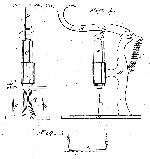 |
Heyl Paper Fastener Press
Based on patent issued in 1877 to Henry R. Heyl (US Patent No. 195,603) ~ Government of Pennsylvania solicited supply in 1879 (Harrisburg Telegraph, June 9, 1879, p. 3)
The Government of Pennsylvania solicited supply of Heyl paper fastening machines in 1879 and Heyl paper fastening presses in 1880. The government of Indianapolis solicited supply of Heyl paper fastener presses in 1880. This 1880 request included prices of $2.25 each for both Heyl's paper fastener presses and McGill's paper fastener presses. This pricing indicates that the Heyl machine was substantial (that is, comparable to the McGill Single-Stroke Staple Press, and unlike the much cheaper Novelty paper fastener). We have not found either an advertisement from a seller of the Heyl press or a surviving machine. The image to the right is from the 1877 patent and may resemble the Heyl paper fastener press that apparently was on the market in 1879-80.
The 1877 Heyl patent (US Patent No. 195,603) was amended and reissued in 1881 (US Reissued Patent No. 9803). After being assigned to George W. Heyl (presumably a relative of the inventor, Henry R. Heyl), this patent was assigned to Isaac W. Heysinger in 1881. Heysinger used the 1877 patent date in connection with each of three machines made by the Philadelphia Novelty Mfg. Co., the Novelty, Keystone, and Original paper fasteners, each of which is discussed below.
In the case of the machines described by both the 1877 original Heyl patent and the 1881 reissued Heyl patent, the user inserted a single staple with the legs pointing up. The papers to be fastened were placed above the staple. In the case of the machine described in the 1877 patent, a first downward blow inserted the staple and bent the legs part of the way inward but did not fully clinch the staple. After the first blow, the user was required to move the papers forward and deliver a second blow to clinch the staple. Because two blows were required, arguably his 1877 patent does not qualify Heyl as the inventor of the desktop stapler. In the case of the machine described in the 1881 reissued patent, a single blow caused the staple to be inserted and clinched. However, between the 1877 and 1881 dates of the original and reissued Heyl patents, George W. McGill received a patent for a single blow staple press, and therefore McGill is now generally identified as the inventor of the desktop stapler.
|
Insert patent diagram |
McGill's Single-Stroke Staple Press
Patented awarded 1879 to George W. McGill US Patent No. 212,316 ~ Advertised 1878 (J. A. Stevens, et al., Magazine of American History, until late 1890s and sold until 1913
Holmes, Booth & Haydens
New York, NY
This machine used individual wire staples similar to staples used today, but the staples did not come glued together in strips.
(Note: By 1876, McGill had marketing brass paper fasteners that resembled staples in that they had two legs that were about a half inch apart. However, these fasteners were punched out of sheet metal, and we have found no evidence that McGill marketed a device to insert, or insert and clinch, these paper fasteners.)
|
 |
McGill's Eagle Staple Press (a.k.a. Criterion Staple Press)
Patented 1879. The patent is the same as that for the McGill Single-Stroke Staple Press (immediately above)
England
English version of McGill's Single-Stroke Staple Press No. 1
|
 |
Brown's Single-Blow Staple Driver
Patented 1879 by William J. Brown, Jr. US Patent No. 218,227
Advertised 1880
William J. Brown, Jr.
Philadelphia, PA
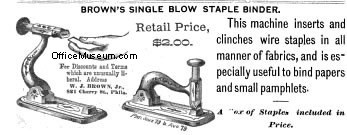
1880 Advertisement
|
 |
Wire-Staple Paper Fastener (a.k.a. Criterion Staple Hand Punch)
Mentioned in R. T. Paine, Contributions to the Science of Charity, 1879, p. 67.
Marshall, Son & Co., Boston, MA
"Directions: Lay the papers or sheets to be fastened upon a soft piece of wood,
pierce with the punch, insert staple, and use oval end of
handle to clinch it." |
 |
Novelty Paper Fastener
Based on Heyl patent issued in 1877 and reissued in 1881 (see above), and on Isaac W. Heysinger patents issued in 1880 (US Patent No. 226,402) and 1883 (US Patent No. 274,941)
Advertised 1880-1910
Philadelphia Novelty Mfg. Co.
Philadelphia, PA
There is an Aug. 7, 1866, patent date on the driver (the vertical part of the device). This may refer to
US Patent No. 56,884, issued to Albert C. Betts on that date for "a new and useful device for holding staples, and... to facilitate the driving of the same. It is more particularly applicable to the making of wire fences where the wires are secured to posts by means of staples." It is conceivable that the manufacturer of the Novelty Paper Fastener acquired this patent and, beginning around 1880, claimed that it covered some detail of the staple driver that was part of the Novelty Paper Fastener. However, this would not imply that any device resembling a desktop stapler was invented in 1866. Therefore, as far as we have been able to determine, the 1866 patent is irrelevant to the timeline for paper fasteners.
A box in which the Novelty Paper Fastener was sold, and an 1886 catalog for the manufacturer, list patents issued from 1877 to 1883 but do not list the 1866 patent.
Insert image from Office 3/87. |
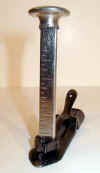 |
McGill's Single-Stroke Staple Press No. 2
Patented 1882 by George W. McGill (US Patent No. 252,841) ~ Advertised 1880 until late 1890s and sold until 1913
Holmes, Booth & Haydens
New York, NY |
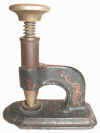 |
Boss Staple Driver
Advertised 1880
W. J. Brown, Jr.
Philadelphia, PA |
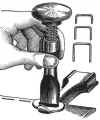 |
Gem Paper Fastener
Advertised 1881
Tower
UK
This device is similar to the 1879 Wire-Staple Paper Fastener above. Both devices were used with staples punched from sheet metal. The devices pierced two holes or slits through sets of papers so that one of these staples could be inserted and clinched by hand.
In the past, someone who had seen the name but not the illustration of the Gem Paper Fastener assumed that the Gem Paper Fastener was the same as the Gem Paper Clip and reached the incorrect conclusion that the Gem Paper Clip originated in the UK around 1881, while in fact it was invented in the US and first marketed in 1892. |
 |
Victor Paper Fastener and Check Canceller
Protected by patents issued in 1879 and 1882 to William J. Brown, Jr. US Patent Nos. 218,227 and 260,365
The 1879 patent is the same patent that protected Brown's Single-Blow Staple Driver (above)
Identified as "new" in publication 1882 ~ Advertised 1882-91
A. A. Weeks
New York, NY
Device is a paper fastener at one end and a check canceller at the other.
Photograph courtesy of Mike Guthrie
|
 |
Keystone Paper Fastener
Based on Heyl patent issued in 1877 and reissued in 1881, and on Heysinger patents issued in 1880 and 1883 (see above)
Advertised 1883-96, 1902, 1910
Philadelphia Novelty Mfg. Co., Philadelphia, PA
The 1877-82 patents, which are listed in the manufacturer's 1886 catalog,
are the same
as those listed for the Novelty Paper Fastener (above) and Original Paper Fastener (below). |
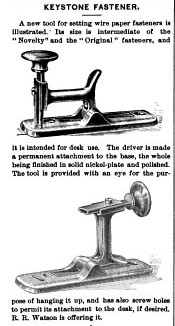
1883 advertisement
 |
Original Paper Fastener
Based on Heyl patent issued in 1877 and reissued in 1881 ~ On Market 1884 ~ Advertised 1885-96
Philadelphia Novelty Mfg. Co.
Philadelphia, PA
In the case of the Original Paper Fastener, the staple was loaded with the legs pointing upward, as in the original 1877 Heyl patent. Some machines marketed to insert metallic paper fasteners other than staples also inserted the points of the fasteners from below the papers; we discuss these on the preceding web page. However, we are not aware of a paper fastener other than the Original that inserted staples with their legs pointing upward.
The Novelty, Keystone, and Original were all on the market from 1884 through 1896. In 1887, the Novelty was $0.50, the Keystone was $0.75, and the Original was $1.50.
|

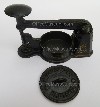 |
Novelty Letter File
Patented 1880 ~ Advertised 1887
Philadelphia Novelty Mfg. Co.
Philadelphia, PA
"Can be used as a clip or as a binder." |
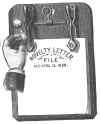 |
Perfect Paper Fastener
Patented 1888
U.S. |
 |
O Kay Staple Driver and Clincher
1889
A. A. Weeks
New York, NY |
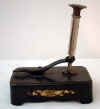 |
McGill's Single-Stroke Staple Press No. 3
Purchased by a government 1900 ~ Advertised 1902
Holmes, Booth & Haydens
New York, NY
Same as the No. 1 but with a substantially longer arm. 1902 advertisement 1902 referenced the patent issued to George W. McGill in 1879 (see above) |
Picture coming.
AC McClurg p. 195. |
Eureka Staple Driver
Advertised 1902
Mentioned in Practical Druggist and Pharmaceutical Review of Reviews, June 1906, p. 413.
A. A. Weeks, New York, NY
According to the box, this device was distributed if not made by A. A. Weeks. Previously A. A. Weeks was associated with Brown/Crawford, rivals of Heyl/Heysinger. Yet A. A. Weeks claimed that this device was protected by a patent issued to Heysinger in 1880 (US Patent No. 226,402, see above)
|
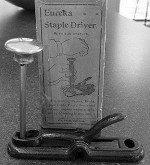
Additional picture coming. H.
AC McClurg p. 195. |
Paris Staple Press
Europe |
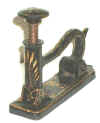 |
Hugo Garthe Staple Press
Hugo Garthe
Elberfeld, Germany
Gold
lettering on base indicates that Hugo Garthe was a supplier of "Maschinen
für Buchbinder, Buch und Steindrucker, Heftdraht, Drahtheftklammern,"
that is, machines for bookbinder, book and lithographic printer, wire stitching
machines. |
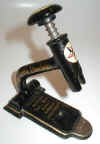 |
Staple Press
Advertised 1908-13 (Germany, Belgium, France)
Germany
|
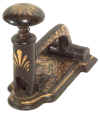
 |
Staple Press
Advertised 1908-11, 1934 (Germany), 1913 (France)
Used to insert staples in the spines of pamphlets.
Photos to right show two slightly different models.

1913 ad, France
|

 |
Staple Press
Advertised 1913 (France)
This appears to be a knock-off of the McGill Single-Stroke Staple Press No. 1 (above).
|
 |
McGill's Staple Press No. 1a with Adjustable Arm
Advertised 1920s for use in fastening textiles
U.K.
Identified by Curtis Scaglione |
 |
Close but Not Quite
| The following device
looks like a paper fastener, but it was used to attach buttons to shoes. |
|
Peninsular Novelty
Button-Fastener
Patented 1884-85
Heaton-Peninsular Button Fastener Co.
Providence, RI (until 1898)
Boston, MA (from 1898)
|
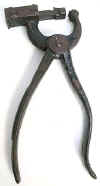 |
Return to Top of this Page
|






















